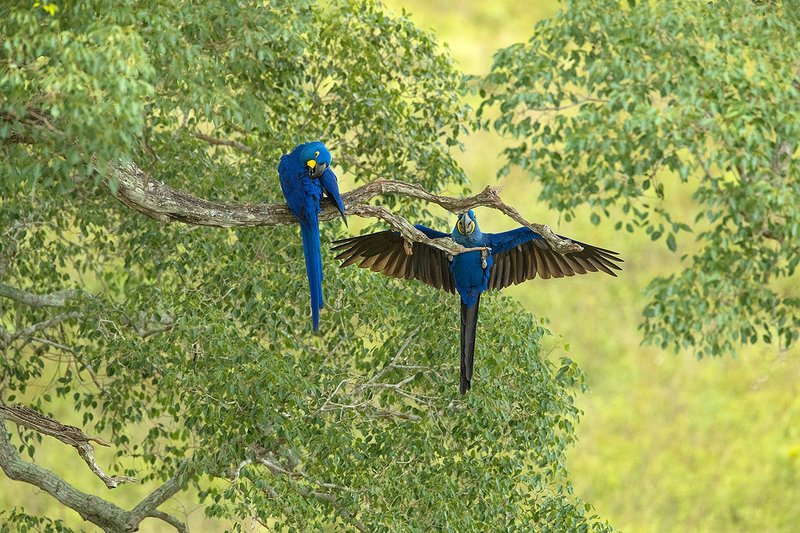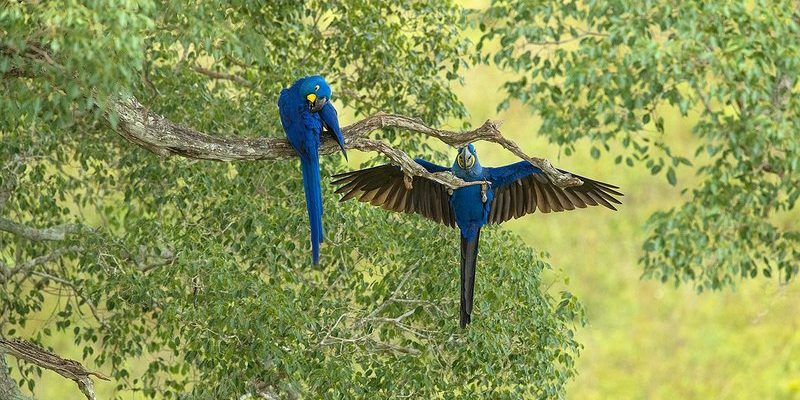
But what does it really mean for a creature like the Hyacinth Macaw to adapt? Well, it’s all about the little tricks and techniques that help them make the most of their environment—much like how a remote control syncs up with our favorite devices, allowing us to enjoy what we love without a hitch. In this piece, we’ll dive deep into how Hyacinth Macaws have become one of the most fascinating birds on our planet through their unique adaptations.
The Natural Habitat of Hyacinth Macaws
To understand how Hyacinth Macaws adapt, we first need to look at their natural habitat. These beautiful birds are predominantly found in the tropical forests of Brazil, Bolivia, and Paraguay. They prefer environments where palms and fruit trees are abundant, as these provide both shelter and food. Picture a lush, green landscape filled with tall trees and vibrant flowers—that’s where you’d find these macaws soaring through the canopy.
They tend to stay close to areas near water sources too, like rivers and lakes. This makes sense when you think about how important water is for their survival. Just like us reaching for a cold drink on a hot day, Hyacinth Macaws rely on these natural water supplies to stay hydrated and energized.
Their preferred habitats help them find plenty of food, which is a crucial part of their adaptation. They love to munch on nuts, seeds, and fruits, especially from the acuri and bocaiuva palms. With strong, curved beaks designed for cracking hard nuts, they’ve perfected their dining habits, making them experts at getting the most nutrition from their environment.
Physical Adaptations for Survival
Hyacinth Macaws are impressive not just for their size but also for their unique physical traits. Their heavy, robust beaks aren’t just for show; they’re essential tools for survival. These beaks allow them to access tough foods that other birds can’t handle, such as hard-shelled nuts. Honestly, imagine having a built-in toolbox that lets you enjoy a snack no one else can!
Their stunning blue feathers serve a couple of purposes too. First, they help with camouflage. While they soar above the forest floor, their blue coloration blends in with the sky and the shimmering leaves, helping them stay hidden from potential predators. Plus, those feathers play a role in temperature regulation, keeping them cool during hot days. You might be wondering how such bright colors work for camouflage; well, birds are often seen as just another part of the environment, blending into the sky above rather than standing out on the forest floor.
Moreover, their strong legs and feet, equipped with two toes facing forward and two backward, allow for a vice-like grip on branches. This adaptation is super helpful for climbing and resting comfortably as they navigate the trees. It’s like having a built-in climbing gear that enables them to move effectively through their habitat.
Behavioral Adaptations
Beyond physical traits, behavioral adaptations are equally vital for the Hyacinth Macaw’s survival. These birds are incredibly social creatures, often forming tight-knit flocks that work together to find food and stay safe from danger. Being part of a group helps them keep an eye out for predators, much like how friends look out for one another in a crowded place.
Hyacinth Macaws also engage in specific feeding behaviors that demonstrate their adaptability. For example, they often use their intelligence to pry open fruit pods and access seeds that are less accessible to other animals. This knack for problem-solving shows their ability to adapt to what’s available in their environment, ensuring they never go hungry.
Furthermore, they communicate with one another through a range of vocalizations and body language. From squawking to subtle movements, their social interactions help build relationships and coordinate activities within their flocks. It’s fascinating how these social behaviors not only support survival but also enrich their lives. Think of it like how we catch up with friends over coffee—these interactions create bonds that strengthen their community.
Breeding and Nesting Adaptations
When it comes to breeding, Hyacinth Macaws show remarkable adaptations that help ensure the survival of their young. They typically choose to nest in tall trees with large cavities, which provide security from both weather and predators. These nests are often located high off the ground, making it difficult for ground-based threats to reach them.
The female lays just 1 to 3 eggs, which may seem like a small number, but it’s a strategic choice. This lower clutch size allows them to better care for their young. They’ll focus their attention and resources on raising just a few chicks, increasing the likelihood of survival for each. Much like how we prioritize quality over quantity in our relationships, these macaws invest deeply in their few offspring.
After the eggs hatch, both parents are involved in feeding and protecting their young. This cooperation demonstrates another layer of their adaptability. By working as a team, they ensure that the chicks have the best chance of growing into independent adults. It’s heartwarming to think of those little macaws snuggled up and learning from their parents, just like we learn from ours.
Conservation and the Future of Hyacinth Macaws
Unfortunately, even with their remarkable adaptations, Hyacinth Macaws face threats from habitat loss and poaching. The destruction of their natural forests for agriculture and development has severely reduced their numbers. The good news is that conservation efforts are underway to protect these beautiful birds and their habitats. Organizations work tirelessly to create protected areas and educate local communities about the importance of preserving these vibrant ecosystems.
Here’s the thing: when we take steps to protect Hyacinth Macaws, we’re not just saving a species—we’re helping to keep the entire ecosystem healthy. These birds play a crucial role in seed dispersal, and without them, the forests could suffer. It’s a reminder that every creature, no matter how big or small, has its place and purpose in the circle of life.
Supporting conservation initiatives can be as simple as spreading the word about these efforts or even supporting organizations that focus on wildlife preservation. With a little help, we can ensure that future generations will witness these spectacular birds in the wild.
Hyacinth Macaws are a shining example of how adaptation can shape the survival of a species. From their impressive physical adaptations to their smart behaviors and social structures, these birds have found creative ways to thrive in their tropical homes. As we’ve explored, it’s not just about surviving; it’s about flourishing in a complex world.
Understanding how Hyacinth Macaws adapt teaches us valuable lessons about resilience and collaboration—lessons we can apply in our own lives. Just like these magnificent birds, we all need to find ways to adapt to the challenges around us, whether we’re navigating our personal lives or working toward broader goals. So, the next time you catch a glimpse of a Hyacinth Macaw soaring through the trees, take a moment to appreciate not just its beauty, but the incredible journey it’s taken to survive and thrive in its environment.

